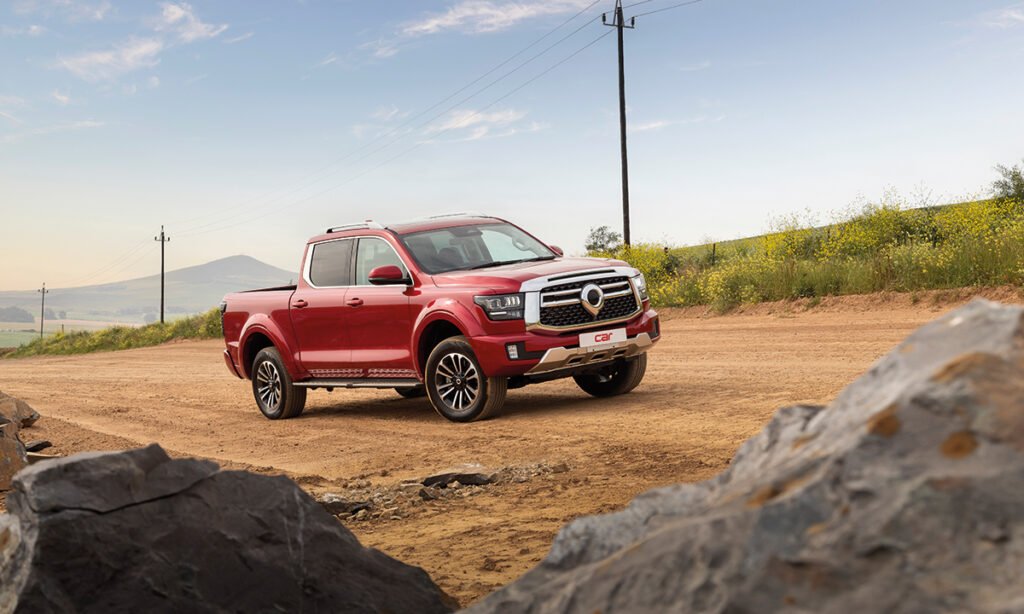Literally and figuratively, GMW’s P500 wants to make a big statement in the SA bakkie segment.

Looking for a new or used set of wheels? Find it here with CARmag!
GWM P500 2.0T HEV 4×4 Ultra Luxury OP Quick Facts
- Price: R999 900
- Engine: 2.0-liter four-cylinder turbo petrol + electric motor
- Transfer: nine-speed automatic
- Current: 255 kW at 5,500-6,000 rpm
- Couple: 648 Nm at 1,700-4,000 rpm
- 0-100 km/h: n/a
- Top speed: n/a
- Fuel consumption: 9.8 l/100 km*
- CO2 emissions: 225g/km
- Rivals: Ford Ranger Wildtrak/Platinum; Toyota Hilux Legend RS; Volkswagen Amarok Aventura
It is bigger in the rapidly growing local bakkie segment Real better? And we’re not just talking about size here. As bakkies have increasingly taken on the role of a family vehicle (as opposed to earlier workhorse applications), bakkies are now more focused than ever on comfort and technology; blurring the once clear line between crew cab SUVs.
In a relatively short time, GWM has proven to be a worthy player among the larger brands in the South African bakkie market. However, with the introduction of the P500 series of double cabs, the Chinese company wants to make a big statement and further disrupt a segment ruled by the likes of Toyota, Ford and Isuzu. The P500 seems to tick all the boxes to meet the conditions set by its maker: big, not only in size, but also in comfort and technology.
Related: Kia SUV gets Tasman styling with digital display
The P500 tested here is equipped with the same HEV powerplant found under the hood of the top-of-the-range Tank 300, which featured in our July 2024 SUV Shootout issue, and the Tank 500. The addition of an electric motor allows the hybrid The setup’s 2.0-litre four-cylinder turbo petrol power output from 180 kW and 380 Nm has been increased to a healthy 255 kW/648 Nm of torque, the latter available from 1,700 rpm.
Although the electric assistance contributes to an increase in power and torque (the electric motor, coupled with a 1.76 kWh lithium-ion battery pack, adds 78 kW and 268 Nm to the hybrid configuration), it does not seem to have any advantage on the in terms of fuel consumption. efficiency front. GWM claims an average fuel consumption of 9.8 l/100 km. However, in our real-world fuel consumption test, the hybrid setup returned 12.37 l/100 km. If the latter figure is matched, a range of 646 km is possible with the P500 HEV’s 80 liter fuel tank.
If fuel economy is one of your key requirements when shopping for a GWM bakkie, you might be better off looking at one of the diesel derivatives in the company’s local P500 portfolio. Although it has less power than some of its rivals (135kW/480Nm), the 2.0-litre four-cylinder turbodiesel, mated to a nine-speed self-shifter, should be less thirsty than the HEV. Here, GWM claims an average fuel consumption of 8.6 l/100 km. We’d love the opportunity to pair our test equipment with a turbodiesel P500 in the future, even though the HEV-powered model should deliver a better performance in terms of performance.
On our test strip, the second most powerful bakkie in South Africa (after the new generation Ranger Raptor) sprinted from a standstill to the three-digit marker in 8.38 seconds. In overtaking acceleration efforts, the 2,578 kg P500 in gear recorded acceleration times of 1.84 and 6.81 seconds between the 60 to 80 km/h and 80 to 120 km/h steps respectively.
However, several members of the CAR team noted that the P500’s automatic transmission mapping could use some improvements, especially when driving uphill at high speed on national roads. Here the otherwise well-calibrated unit tended to stick to higher gear ratios, hampering the bakkie’s momentum on uphill sections.
In the default setting, some team members noticed that the handlebar setup felt a little too light. However, as with many functions of the P500, its calibration can be adjusted to the driver’s preference via one of the submenus in the infotainment system.
Thanks to independent double wishbone front suspension and live axle rear suspension, the P500 is supple and absorbs most road imperfections with aplomb. The arrangement also appeared to be composite on corrugated gravel surfaces. Furthermore, thanks to the interior’s solid construction, the cabin proved well insulated against road and tire noise, with only a hint of wind penetrating the cabin when driving on the national border.
Brought to a halt by ventilated brake discs, set behind 18-inch alloy wheels wrapped in 265/60 Giti GitiXross rubber, the P500 test unit recorded an average stopping time of 3.13 seconds, over 45.91 meters, during our rigorous 10-stop emergency braking test. These figures gave the P500 HEV a ‘good’ rating by our standards.
Related: Nissan’s Patrol Opts for V6 in Latest-Generation Model
Available exclusively in the Ultra Luxury trim level, the standard specification list of the P500 HEV is impressive. Technology plus points include digital instruments, a head-up display, a 14.6-inch touchscreen infotainment system with wireless Apple CarPlay and Android Auto, a 10-speaker Infinity sound system, wireless smartphone charging pads front and rear and a 360-degree surround-view camera setup supplemented with parking distance sensors front and rear.
Like the electrically adjustable front seats, which offer massage functionality, the leather-trimmed, 50:50 split rear seat, fitted with under-seat storage compartments, is heated and ventilated. The electrically adjustable (height-adjustable) multifunction steering wheel also offers a heating function. Mood lighting is also included in the package.
The spaciousness of the cabin is worth mentioning. Although the top-spec P500 comes with a panoramic sunroof, it offers plenty of headroom for both front and rear occupants (790-860mm and 855mm respectively). In addition, passengers sitting on the electrically adjustable (forward and rearward) rear seats have between 580 and 630 mm of legroom.
A first in the local bakkie segment, the P500’s 60:40 split tailgate provides hassle-free access to the load floor, which is equipped with 28 anchor points. While the latter feature was appreciated, some CAR team members questioned the durability of the tailgate opening button. In addition, it is worth noting that the P500’s payload is smaller than that of its car Match up rivals.
When we crowned our Top 12 Best Buys winners of 2024 (November 2023), the Ford Ranger took the top spot in the double-cab bakkies category; with its SA-built brethren, the Toyota Hilux and Isuzu D-Max, claiming second and third place respectively. However, we did note that the GWM P-series is “worth mentioning”, with the Chinese carmaker’s bakkie having “shocked the local establishment” with its “impressive build quality and value for money”.
With the P500, GWM has taken another impressive step into the double cab segment. However, it is significantly more expensive than the range-topping 2.0TD LTD 4×4 P-Series stablemate tested in August 2023. But considering the increase in power and torque offered by the 2.4-litre turbo-diesel and HEV powertrains, the improved driving dynamics, overall comfort, solid build quality and impressive amount of standard technology; for many, the premium may be worth it. However, although untested, we’d argue that the R110,000-cheaper mid-range turbodiesel is the P500 par excellence.
You will find the full article in the November issue of CAR Magazine.
Browse thousands of new and used vehicles here with CARmag!

